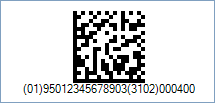GS1 DataMatrix Barcode
This Symbology is also known as GS1 2D DataMatrix
This Barcode Symbology is supported by the following Neodynamic products:- Barcode Professional SDK for .NET Projects
- Barcode Professional for Windows Forms
- BarcodePro Web API for Docker
- Barcode Professional for WPF
- Barcode Professional for XAML WinRT Windows Store
- Barcode Professional for ASP.NET (Web Forms, MVC Razor, AJAX)
- Barcode Professional for Silverlight LOB
- Barcode Professional for Reporting Services (CRI & DLL for SSRS (RDL))
- Barcode Professional for .NET STANDARD
- Barcode Professional for Blazor
- ThermalLabel SDK for .NET
- Barcode Professional for Windows Phone
Overview
 GS1 DataMatrix allows you to encode GS1 System Application Identifiers (AI) into DataMatrix 2D barcodes.
GS1 DataMatrix allows you to encode GS1 System Application Identifiers (AI) into DataMatrix 2D barcodes.
GS1 was developed to provide a worldwide format and standard for exchanging common data between companies. While other barcodes simply encode data with no respect for what the data represents, GS1 System encodes data and encodes what that data represents.
GS1 System has a list of Application Identifiers (AI). The Application Identifier is a 2, 3, or 4-digit number that identifies the type of data which follows. By convention, the Application Identifier is enclosed in parentheses when printed below the barcode (the parentheses are only for visual clarity, and are not encoded in the barcode).
GS1 DataNatrix is based on DataMatrix ECC200 barcode standard (ISO/IEC 16022), which is a two-dimensional (2D) barcode symbology which can store from 1 to about 2,000 characters, supporting advanced encoding error checking and correction algorithms (reed-solomon).
How to encode GS1 DataMatrix using Barcode Professional
Introduction
GS1 System encodes the so called Element Strings which are composed of an Application Identifier (AI) plus a data field. Each AI identifies the meaning and format of the data following it. The code FNC1 (Function 1 Character) is generally used to concatenate two or more data fields in a unique barcode image (FNC1 is automatically handled by Barcode Professional products).
Examples
Encoding single AIs
The following example encodes a Global Trade Item Number (GTIN) 95012345678903 - with AI 01 (Shipping Contained Code) - into a GS1 DataMatrix barcode
Code property = (01)95012345678903 will produce the following barcode image:

- Concatenation of the Pre-Defined Length Element Strings
Concatenated Element Strings constructed from Application Identifiers with a pre-defined length do not require a Separator Character (FNC1). Each Element String is immediately followed by either the next Application Identifier or the Symbol Check Character and Stop Character.
Example
Concatenation of net weight (4 kg) with the associated Global Trade Item Number (GTIN) 95012345678903 does not require the use of a Separator Character (FNC1).
AI 01 (Shipping Contained Code) has a pre-defined Element String length of 16 digits.
AI 31 (Product Net Weight in Kg) has a pre-defined Element String length of 10 digits.
Code property = (01)95012345678903(3102)000400 will produce the following barcode image:

- Concatenation of Variable Length Data Strings
Concatenating Element Strings of variable length involves the use of a Separator Character (FNC1). It is placed immediately after the last symbol character of a variable length data string and is followed by the Application Identifier of the next Element String. If the Element String is the last to be encoded, it is followed by the Symbol Check and Stop Characters and not the FNC1 Separator Character.
Example
Concatenation of AI 8005 Price per Unit of Measure (365 currency units) and AI 10 Batch Numbers (123456) requires the use of a Separator Character (FNC1) immediately after the price per unit of measure.
Code property = (8005)000365(10)123456 will produce the following barcode image:


